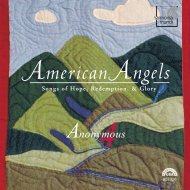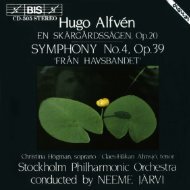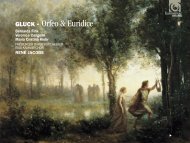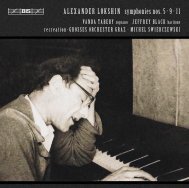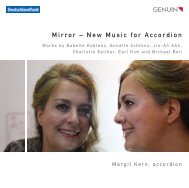Mise en page NUM - eClassical
Mise en page NUM - eClassical
Mise en page NUM - eClassical
Create successful ePaper yourself
Turn your PDF publications into a flip-book with our unique Google optimized e-Paper software.
In this second volume devoted to secular music, the Ensemble<br />
vocal Aedes continues its exploration of the a cappella choral<br />
repertoire of the tw<strong>en</strong>tieth and tw<strong>en</strong>ty-first c<strong>en</strong>turies.<br />
Continuing along the same lines as the first volume (Ludus<br />
verbalis, Eloqu<strong>en</strong>s EL1128) we have selected sev<strong>en</strong> cycles in<br />
which musical creativity c<strong>en</strong>tres on the word, its sonority, its<br />
ludic aspect and its powers of evocation.<br />
The texts are eclectic, with poems by William Butler Yeats,<br />
Rainer Maria Rilke, Guillaume Apollinaire, Paul Éluard and<br />
William Shakespeare, but also anonymous medieval English<br />
pieces, traditional songs from Moravia, and one cycle with<br />
texts by the composer himself.<br />
Again, several criteria guided us in our choice: a wish to<br />
alternate classics of the vocal repertoire with lesser-known<br />
works (and a new one, a commission), to repres<strong>en</strong>t several<br />
differ<strong>en</strong>t countries, each with a rich choral tradition, and to<br />
give priority to the art song.<br />
We thought it would be interesting too to show how the<br />
literary culture and tradition of a country can shape, inspire,<br />
influ<strong>en</strong>ce and sometimes dictate a mode of composition,<br />
especially wh<strong>en</strong> a composer chooses pieces writt<strong>en</strong> in a<br />
language that is not his own.<br />
In Sacred and Profane by B<strong>en</strong>jamin Britt<strong>en</strong>, which op<strong>en</strong>s this<br />
recording, the sacred texts, like the secular ones, are treated<br />
in the manner of madrigals depicting human passions. This<br />
cycle looks towards the last two volumes in this series of four,<br />
which will be devoted to sacred music for a cappella choir.<br />
Writt<strong>en</strong> a year before his death by a composer at the height<br />
of his musical powers, Sacred and Profane is a fascinating<br />
cycle, varied in its styles and moods. Carnal love, divine love,<br />
country pleasures… The beautifully crafted music magnifies<br />
the texts (both secular and sacred, in Old English), especially<br />
in the last piece, A death, in which B<strong>en</strong>jamin Britt<strong>en</strong> (1913-<br />
1976) gives a musical account of all the stages in the death<br />
of a man, who seems little affected by what is happ<strong>en</strong>ing<br />
to him!<br />
In 2011, wishing to make our own contribution to the<br />
continuance of the great English choral tradition, we<br />
commissioned Philip Lawson (b. 1957) to compose a work<br />
for us. Of this composition he wrote: ‘I have long be<strong>en</strong> an<br />
admirer of the poetry of W. B. Yeats. So wh<strong>en</strong> I was<br />
approached to write a cycle of three pieces for the Ensemble<br />
vocal Aedes, I worked on putting together a trilogy of Yeats’s<br />
poems for the choir. My little sequ<strong>en</strong>ce traces the love of a<br />
man for a young lady, starting with his seeming <strong>en</strong>vy of her<br />
innoc<strong>en</strong>ce, yet to be hurt by love. The second movem<strong>en</strong>t sets<br />
Yeats’s famous poem of adoration, Had I the heav’n’s<br />
embroidered cloths, and in the last the poet imagines the<br />
girl as an old woman, and hopes she will remember him, the<br />
“one man [who] loved the pilgrim soul in you”.’<br />
Wh<strong>en</strong> Frank Martin (1890-1974), a Swiss composer and<br />
contemporary of Britt<strong>en</strong>, composed his Songs of Ariel in<br />
1950, he did not simply set to music excerpts from William<br />
Shakespeare’s The Tempest: the arrangem<strong>en</strong>t of the English<br />
text and its sound seem to have fired his imagination and<br />
tak<strong>en</strong> his music along the same path as the English masters,<br />
although the musical language is distinctively his own,<br />
based notably on a very expressive use of chromaticism. In<br />
this opus, which makes ext<strong>en</strong>sive use of word-painting,







